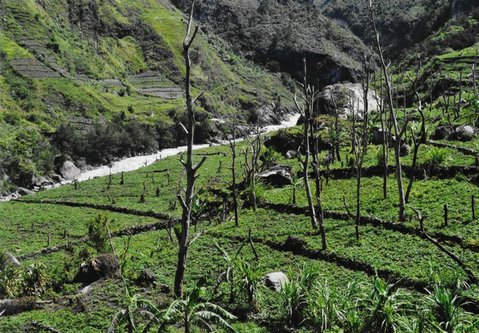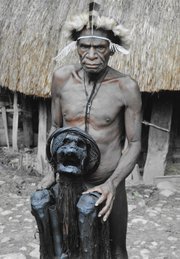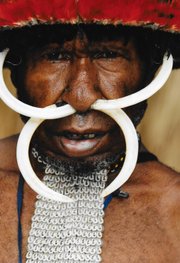
Craig Harris , a village garden in Papua
Source: Craig Harris
Nestled in a remote corner of the world, some two million Melanesian people live in an area of rain forest, swamps, and cloud-snagged mountains reaching to heights of 16,000 feet, the highest elevation between the Himalayas and the Andes. I’m with my friend Tinus, deep in the jungle of West Papua, hunting birds perched high in the canopy with bow and arrow. Overhead, dark clouds loom, and thunder shakes the ground. Tinus believes they carry a message. He has heard from neighboring tribes of unwanted visitors promising knives and tools and, with them, change.
For thousands of years, Tinus’s people — the Lani tribe — have remained cut off from the outside world, their reality fixed upon an area of forest unmapped and forgotten. The skillful life of a nomadic hunter-gatherer is all my friend has ever known. His bamboo arrow takes flight, and soon he is diligently wrapping the bird in banana leaves for the long trek home. Nearly 30 years ago, I met Tinus on my first visit to Papua — Indonesia’s 26th province, situated on an island split down the middle; the eastern half is the independent Oceanian country of Papua New Guinea. For years I worked as a tour guide, sharing my knowledge of the region with those few individuals who desired a glimpse of what the National Geographic calls “one of the wildest, most isolated frontiers on earth.” But on this visit I wanted to verify a village burning in the Lanny Jaya area and continue filming the West Papuan refugees living in Papua New Guinea.
 Picture on Left: (Craig Harris) A Lani tribesman shows a mummy of a “big man” who was important in the village. The mummy lives in his own hut and is asked questions of importance by the village when needed. Harris said he only knew of three mummies through out the highlands.
Picture on Left: (Craig Harris) A Lani tribesman shows a mummy of a “big man” who was important in the village. The mummy lives in his own hut and is asked questions of importance by the village when needed. Harris said he only knew of three mummies through out the highlands.
When Indonesia first took control over Papua in 1969, the indigenous people did not embrace their new rulers. To the Indonesians, it seemed to matter little that the people of Papua belonged to a different culture — that of the South Seas, with animist beliefs and prayers to the gods of water and sun, traditions of head hunting and cannibalism, an economy based on pigs rather than money. Papuans had hardly anything in common with Indonesia’s Asian and predominantly Muslim culture, which abhors pork. The Papuans immediately created a rebel movement that quickly grew as people became angered by the central government’s authoritarian approach.
Armed with arrows and spears as well as a few guns that were obsolete booty from the Dutch — who relinquished control of “Netherlands New Guinea” in 1962 — the rebels founded the Organisi Papua Merdeka (OPM), or Organization Free Papua. The OPM has been at battle with the Indonesian military for years, a movement that beats in the heart of most all Papuans. As one fighter explained, “You cannot throw money at a few Papuans in hopes that change will occur and our aspirations for independence will settle.” Yale University estimates over 100,000 Papuans have died in the conflict. In 1986, the Indonesian army attacked mountain villages with air and ground forces in an operation called Operasi Sate, or Operation Skewered Meat. Some sources state the use of napalm caused thousands to flee to neighboring Papua New Guinea.

Picture on right:
(Craig Harris)
This Lani tribesman is dressed for a ceremony, which includes boar tusks through his septum.
Some 10,000 Papuan refugees have filtered into Papua New Guinea over the last 30 years. Most live in camps just across the border in an area called Vanimo, largely funded by the Papua New Guinea government and local church organizations. The camps are overseen by the landowners. Nervous and scared, the refugees were fearful of speaking when I visited the camps. A landowner asked for my documents and wanted to escort me to jail when I explained I had none. I was in an area off-limits to foreigners, he said. This conversation went on for some time before he asked for money and the promise I would never return.
At the border crossing from Papua New Guinea to Indonesian Papua, I heard that three military personnel had been shot and killed right at the crossing the month before. The border had only recently reopened. As I made my way into Jayapura, the capital of West Papua, my mind drifted to the two French journalists who recently were thrown into a Jayapuran jail for abusing their visas. The Indonesian government does not allow journalists into Papua and to try and apply for the proper documents is fruitless. The two journalists were caught talking to the OPM and filming highly sensitive areas. They may face subversion charges, which carry a jail sentence of 5-10 years.
Once in West Papua — the westernmost piece of Papua, formerly known as Irian Jaya — I sought out my contacts, who explained that, yes, the area of Lanny Jaya was sealed off by the Indonesian military. Apparently they were after some Papuans from the resistance movement who had shot and killed two military personnel. These skirmishes arise on a daily basis, and my friends tell me things have only gotten worse. The Indonesian military, calling them “backward and ignorant,” was inducing people to adopt Western dress and abandon the traditional attire based on materials from the forest.
And the Papuan’s respect for the land was under assault. Many worried that the Indonesian government’s contracts with multinational corporations — there to exploit the forest, gold, and copper — would lead to irrevocable environmental damage and displace Papuans, changing their lives forever. The government had also moved about 200,000 Indonesians from overpopulated islands, like Java and Sulawesi, to this faraway area, where many became homesick and felt isolated. Nonetheless, at this rate, Human Rights Watch estimates transmigrants will become the dominant population in 20 years. The tactic to flood out the indigenous West Papuans includes giving the new arrivals land for shops and other posts of superiority; they look down at the Papuans.
The intensity of the ongoing battles between the military and the resistance movement, my friends said, meant tourism to West Papua — a peninsula where untouched tribes form a part of its mystique —was down at least 90 percent. Many tour operators have pulled out, and the Papuans who worked as guides or porters can no longer find employment. One U.S. adventure tour company explained that the liability is just too high to continue sending clients to this volatile area.
West Papua’s remoteness has enabled its culture and tradition to remain intact for the most part. Bow-and-arrow hunting as well as traditional village compounds are still visible. But the government’s silencing of journalists and battles against the rebels have remained equally invisible to the outside world. Its ill-fated policies of special autonomy have only fueled the archipelago’s desire for self-determination and created a closer bond between the resistance and Papuan academics who fight the battle through peaceful dialogue.
During my visit, Tinus and I had laughed at how old we’re getting and the gray hair that now covers both our heads. I tell him I’ll try and return within the next few years, but we both know a lot can happen before then. In the 27 years I have trekked through West Papua’s highlands, what I have learned about the people and their land has grabbed my heart. My friend expresses the thought that pounds through the heads of many of the two million indigenous Papuans: Can we simply live a peaceful existence?
- Elizabeth1's blog
- Log in to post comments
